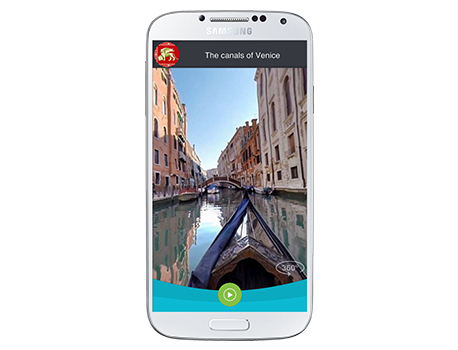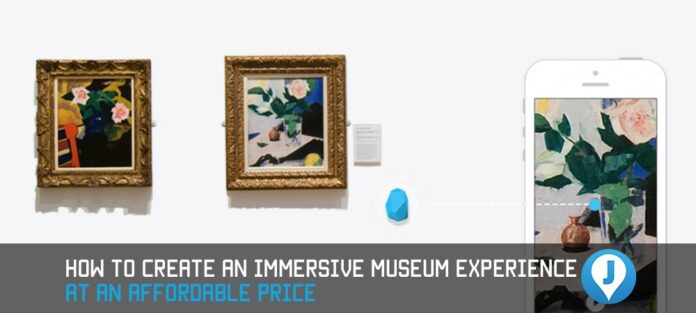By: Kate
Publisher: Medium
Date: April 14th 2016
‘Immersive experience’ is a buzzword in the museum industry for a reason. Visitors’ expectations are constantly growing. They demand more interaction, emotions and engagement with the cultural objects. They want to be completely involved in the atmosphere of the exhibition. That is why storytelling is the key to the museum experience and adding tech makes the experience immersive.
Creating an immersive museum experience has its own issues such as a high cost and long period of development. In this article you will find not only hot tech but also the affordable solution to easily create immersive, story-driven museum experiences.
Still lots of museums and galleries offer printed booklets, large pieces of paper with information and if lucky a «hardware» audio guide to engage visitors. If museums want to offer an immersive experience to a broad range of the audience in today’s media-saturated world, it will require understanding and embracing 21st- century media technologies.
‘Immersive’ refers to the concept when something seems to surround the audience in a way that they feel completely involved. How does it apply to museums?
21st century museums have a great set of digital tools to apply immersive storytelling by strengthening emotional contextual connections between visitors and the exhibits. The immersive museum experience attracts diverse audiences and increases visitors’ engagement, interaction and loyalty.
AUGMENTED REALITY

Augmented Reality (AR) has been a hot topic in the museum community for some time. AR is one of the most successful real-world uses of interactive digital storytelling.
Augmented reality is the integration of digital information in the user’s environment in real time. Unlike virtual reality, which creates a totally artificial environment, augmented reality uses the existing environment and overlays new information on top of it.
Usually a user views the overlay contextually relevant information through the camera lens on a mobile device. Basically, mediated through the phone’s camera, the user sees virtual content suspended in the filmed space as if the device has “magically uncovered” it.
iBEACONS

iBeacons are small wireless sensors that communicate with Bluetooth-enabled smart devices by continuously sending information about their location using a Bluetooth low-energy radio transmitter. In turn, smart devices monitor the received signal strength indication and determine the device’s proximity to the beacon. Beacons offer museums an opportunity to provide context to visitors like never before.
Targeted content & visitor engagement: With beacons, a mobile app provides a visitor with relevant information according to his location. The information delivered at the right place and at the right moment, increases interaction and engagement which makes a huge difference between a usual visit and a long-lasting memory.
360° VIDEOS

A 360° video is created with a camera system that simultaneously records all 360 degrees of a scene. Viewers can rotate a 360° video’s perspective to watch it from different angles. On iOS and Android mobile devices, the viewing angle of a 360° video is changed by dragging a finger across the screen or by navigating with the device.
PHOTO OVERLAYS

Let your visitors take a picture in a Victorian dress or a viking outfit without them actually putting it on. A photo overlay is a graphically designed object that allows museums to use their logo and exhibition-related designs, so visitors can take and share memorable pictures on social media. Easy, simple, engaging and an extra way to promote your activities.
MISSIONS AND CHALLENGES

Museums can increase the visitor’s interest and involvement if they manage to carefully unfold the story behind the exhibition. This can be achieved by introducing gamification elements. Enrich the museum experience by adding fun challenges, quizzes, puzzles and much more. Guide the visitor with a storyline, unlock new destinations and reward the explorer. The more fun — the more visitors will learn and remembe
GREAT NEWS FOR MUSEUMS
Great news is that at OJOO, we offer an affordable and top-notch solution for museums to be able to create immersive experiences without compromising on time, quality or opportunities.
USER FRIENDLY INTUITIVE PLATFORM
The OJOO Design Studio is a complete platform where you can easily transform your idea into a unique mobile app. The Design Studio is self-manageable and user-friendly. It is a great opportunity to create an affordable engaging experience with the hottest technologies for your museum.

Source: https://medium.com/@kate_ojoo/how-to-create-an-immersive-museum-experience-at-an-affordable-price-b2ec63d21bce
Comment: This article focuses on the technological possibilities that museums and other interaction based projects could utilize to promote immersion in their facilities. This primarily relies on AR and NFC based technologies. While I feel AR is not something that could be integrated into many AM developed pieces, NFC technology certainly could be. Let us take a Star Wars door for example. An AM piece could be installed into the doors lock. Users could approach the door with their phones after completing a certain set of tasks and place their phone near the door to unlock it using NFC technology. This would certainly increase immersion by making it essential to use some kind of phone to interact with the environment. While I feel AM technology primarily has a role in producing structures, the combination of AM technology with other interactive tech out there could yield promising methods to increase immersion at interactive based experiences.




